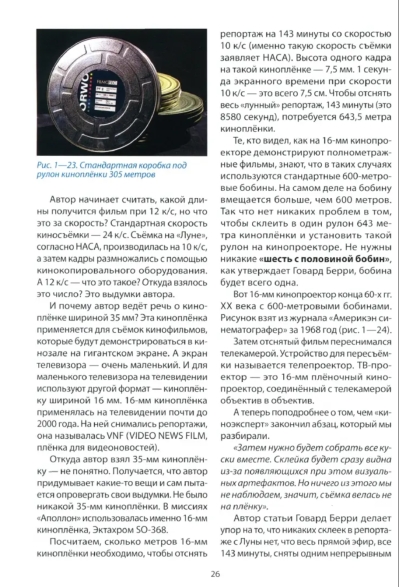When will the US admit that it never went to the moon?
39.99 €
The only thing available 1
The author of this book is cameraman L. Konovalov, who knows very well how combined shooting is done and what film materials are used for this. For 30 years he has been lecturing at film institutes and film schools (VGIK, Moscow Film School, "Lestnitsa" film school).
Having looked at almost all the "lunar" photographs posted on the official NASA website (and there are several thousand of them) and dozens of hours of "lunar" video footage, the cameraman came to the conclusion that these shots are no different in technique from Hollywood films of the 60-70s of the last century on space themes. Actors are filmed in medium shots, and in long shots and long shots, where it is necessary to show vast lunar landscapes, instead of astronauts, dolls (about 25-30 cm high) and models of the lunar module (miniatures) on a scale of 1:6 to 1:10 are used. The lunar mountains in many pictures are a projection of a slide onto a movie screen behind the astronaut.
From the book, you will learn a lot of unexpected and sometimes even shocking information about the fact that the takeoff from the Moon was filmed with an inverted movie camera and the lunar module did not actually take off, but its reduced copy fell down from the ceiling of the pavilion. And that no special compact "lunar" television cameras existed at all. And that the astronaut in zero gravity was portrayed by an actor suspended on a cable in the pavilion.
The book focuses primarily on the voyage to the Moon (1969-1972), but the scope of the study is much broader: it begins with the flights of the single-seat Mercury (1961), the two-seat Gemini, and ends with the sending of the Perseverance rover to Mars (2021).
Having looked at almost all the "lunar" photographs posted on the official NASA website (and there are several thousand of them) and dozens of hours of "lunar" video footage, the cameraman came to the conclusion that these shots are no different in technique from Hollywood films of the 60-70s of the last century on space themes. Actors are filmed in medium shots, and in long shots and long shots, where it is necessary to show vast lunar landscapes, instead of astronauts, dolls (about 25-30 cm high) and models of the lunar module (miniatures) on a scale of 1:6 to 1:10 are used. The lunar mountains in many pictures are a projection of a slide onto a movie screen behind the astronaut.
From the book, you will learn a lot of unexpected and sometimes even shocking information about the fact that the takeoff from the Moon was filmed with an inverted movie camera and the lunar module did not actually take off, but its reduced copy fell down from the ceiling of the pavilion. And that no special compact "lunar" television cameras existed at all. And that the astronaut in zero gravity was portrayed by an actor suspended on a cable in the pavilion.
The book focuses primarily on the voyage to the Moon (1969-1972), but the scope of the study is much broader: it begins with the flights of the single-seat Mercury (1961), the two-seat Gemini, and ends with the sending of the Perseverance rover to Mars (2021).
See also:
- All books by the publisher
- All books by the author























